Exploring the Australian Healthcare Funding Models and Their Impact
VerifiedAdded on 2023/06/03
|7
|1604
|110
Essay
AI Summary
This essay provides an overview of the Australian healthcare funding models, focusing on best practice pricing (BPP), normative theory, quality structures pricing, and safety and quality funding. It evaluates the National Efficient Price (NEP) and Activity-Based Financing (ABF) model, highlighting their role in distributing commonwealth finances to local healthcare facilities. The essay discusses the advantages of ABF, such as equitable resource distribution and transparency, while also addressing potential shortcomings like incentivizing a shift of services back into hospitals. It references various implementations of these models, including the National Health Services (NHS) in the UK and initiatives in Queensland and Victoria. The essay concludes that ABF enhances efficiency, improves healthcare quality, and promotes transparent resource utilization.

Running head: THE AUSTRALIAN HEALTHCARE FUNDING MODELS 1
The Australian Healthcare Funding Models
Name
Institution
Course
Date
The Australian Healthcare Funding Models
Name
Institution
Course
Date
Paraphrase This Document
Need a fresh take? Get an instant paraphrase of this document with our AI Paraphraser
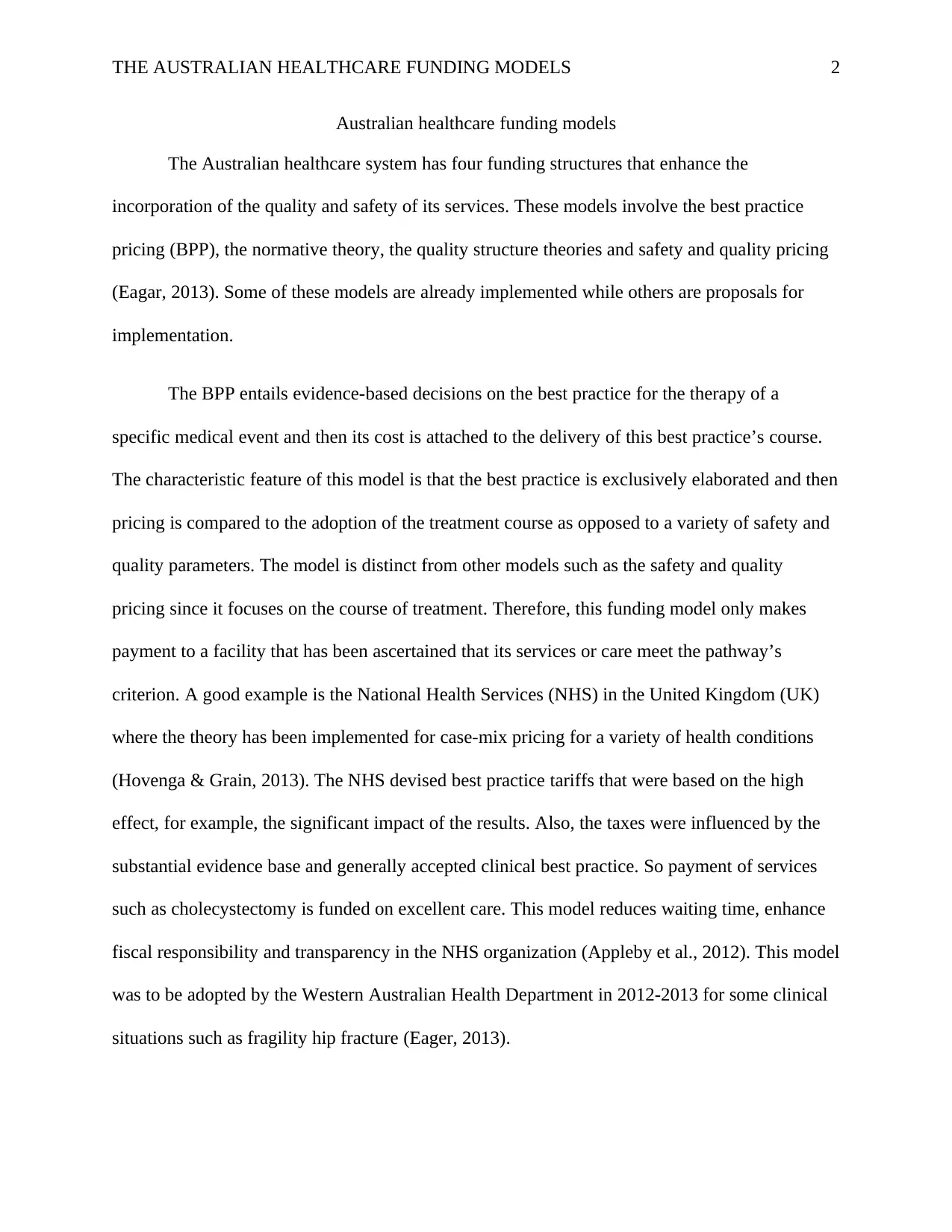
THE AUSTRALIAN HEALTHCARE FUNDING MODELS 2
Australian healthcare funding models
The Australian healthcare system has four funding structures that enhance the
incorporation of the quality and safety of its services. These models involve the best practice
pricing (BPP), the normative theory, the quality structure theories and safety and quality pricing
(Eagar, 2013). Some of these models are already implemented while others are proposals for
implementation.
The BPP entails evidence-based decisions on the best practice for the therapy of a
specific medical event and then its cost is attached to the delivery of this best practice’s course.
The characteristic feature of this model is that the best practice is exclusively elaborated and then
pricing is compared to the adoption of the treatment course as opposed to a variety of safety and
quality parameters. The model is distinct from other models such as the safety and quality
pricing since it focuses on the course of treatment. Therefore, this funding model only makes
payment to a facility that has been ascertained that its services or care meet the pathway’s
criterion. A good example is the National Health Services (NHS) in the United Kingdom (UK)
where the theory has been implemented for case-mix pricing for a variety of health conditions
(Hovenga & Grain, 2013). The NHS devised best practice tariffs that were based on the high
effect, for example, the significant impact of the results. Also, the taxes were influenced by the
substantial evidence base and generally accepted clinical best practice. So payment of services
such as cholecystectomy is funded on excellent care. This model reduces waiting time, enhance
fiscal responsibility and transparency in the NHS organization (Appleby et al., 2012). This model
was to be adopted by the Western Australian Health Department in 2012-2013 for some clinical
situations such as fragility hip fracture (Eager, 2013).
Australian healthcare funding models
The Australian healthcare system has four funding structures that enhance the
incorporation of the quality and safety of its services. These models involve the best practice
pricing (BPP), the normative theory, the quality structure theories and safety and quality pricing
(Eagar, 2013). Some of these models are already implemented while others are proposals for
implementation.
The BPP entails evidence-based decisions on the best practice for the therapy of a
specific medical event and then its cost is attached to the delivery of this best practice’s course.
The characteristic feature of this model is that the best practice is exclusively elaborated and then
pricing is compared to the adoption of the treatment course as opposed to a variety of safety and
quality parameters. The model is distinct from other models such as the safety and quality
pricing since it focuses on the course of treatment. Therefore, this funding model only makes
payment to a facility that has been ascertained that its services or care meet the pathway’s
criterion. A good example is the National Health Services (NHS) in the United Kingdom (UK)
where the theory has been implemented for case-mix pricing for a variety of health conditions
(Hovenga & Grain, 2013). The NHS devised best practice tariffs that were based on the high
effect, for example, the significant impact of the results. Also, the taxes were influenced by the
substantial evidence base and generally accepted clinical best practice. So payment of services
such as cholecystectomy is funded on excellent care. This model reduces waiting time, enhance
fiscal responsibility and transparency in the NHS organization (Appleby et al., 2012). This model
was to be adopted by the Western Australian Health Department in 2012-2013 for some clinical
situations such as fragility hip fracture (Eager, 2013).
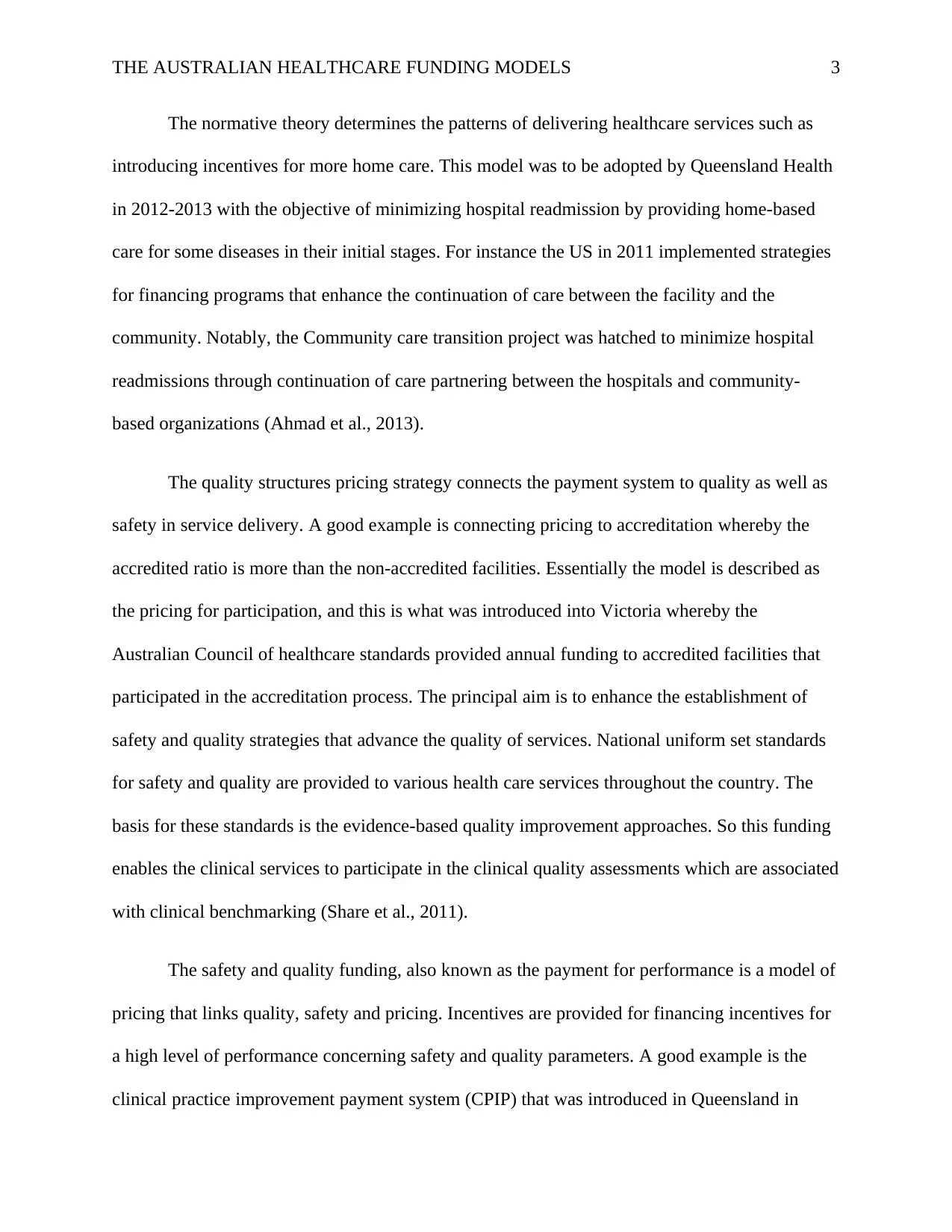
THE AUSTRALIAN HEALTHCARE FUNDING MODELS 3
The normative theory determines the patterns of delivering healthcare services such as
introducing incentives for more home care. This model was to be adopted by Queensland Health
in 2012-2013 with the objective of minimizing hospital readmission by providing home-based
care for some diseases in their initial stages. For instance the US in 2011 implemented strategies
for financing programs that enhance the continuation of care between the facility and the
community. Notably, the Community care transition project was hatched to minimize hospital
readmissions through continuation of care partnering between the hospitals and community-
based organizations (Ahmad et al., 2013).
The quality structures pricing strategy connects the payment system to quality as well as
safety in service delivery. A good example is connecting pricing to accreditation whereby the
accredited ratio is more than the non-accredited facilities. Essentially the model is described as
the pricing for participation, and this is what was introduced into Victoria whereby the
Australian Council of healthcare standards provided annual funding to accredited facilities that
participated in the accreditation process. The principal aim is to enhance the establishment of
safety and quality strategies that advance the quality of services. National uniform set standards
for safety and quality are provided to various health care services throughout the country. The
basis for these standards is the evidence-based quality improvement approaches. So this funding
enables the clinical services to participate in the clinical quality assessments which are associated
with clinical benchmarking (Share et al., 2011).
The safety and quality funding, also known as the payment for performance is a model of
pricing that links quality, safety and pricing. Incentives are provided for financing incentives for
a high level of performance concerning safety and quality parameters. A good example is the
clinical practice improvement payment system (CPIP) that was introduced in Queensland in
The normative theory determines the patterns of delivering healthcare services such as
introducing incentives for more home care. This model was to be adopted by Queensland Health
in 2012-2013 with the objective of minimizing hospital readmission by providing home-based
care for some diseases in their initial stages. For instance the US in 2011 implemented strategies
for financing programs that enhance the continuation of care between the facility and the
community. Notably, the Community care transition project was hatched to minimize hospital
readmissions through continuation of care partnering between the hospitals and community-
based organizations (Ahmad et al., 2013).
The quality structures pricing strategy connects the payment system to quality as well as
safety in service delivery. A good example is connecting pricing to accreditation whereby the
accredited ratio is more than the non-accredited facilities. Essentially the model is described as
the pricing for participation, and this is what was introduced into Victoria whereby the
Australian Council of healthcare standards provided annual funding to accredited facilities that
participated in the accreditation process. The principal aim is to enhance the establishment of
safety and quality strategies that advance the quality of services. National uniform set standards
for safety and quality are provided to various health care services throughout the country. The
basis for these standards is the evidence-based quality improvement approaches. So this funding
enables the clinical services to participate in the clinical quality assessments which are associated
with clinical benchmarking (Share et al., 2011).
The safety and quality funding, also known as the payment for performance is a model of
pricing that links quality, safety and pricing. Incentives are provided for financing incentives for
a high level of performance concerning safety and quality parameters. A good example is the
clinical practice improvement payment system (CPIP) that was introduced in Queensland in
⊘ This is a preview!⊘
Do you want full access?
Subscribe today to unlock all pages.

Trusted by 1+ million students worldwide
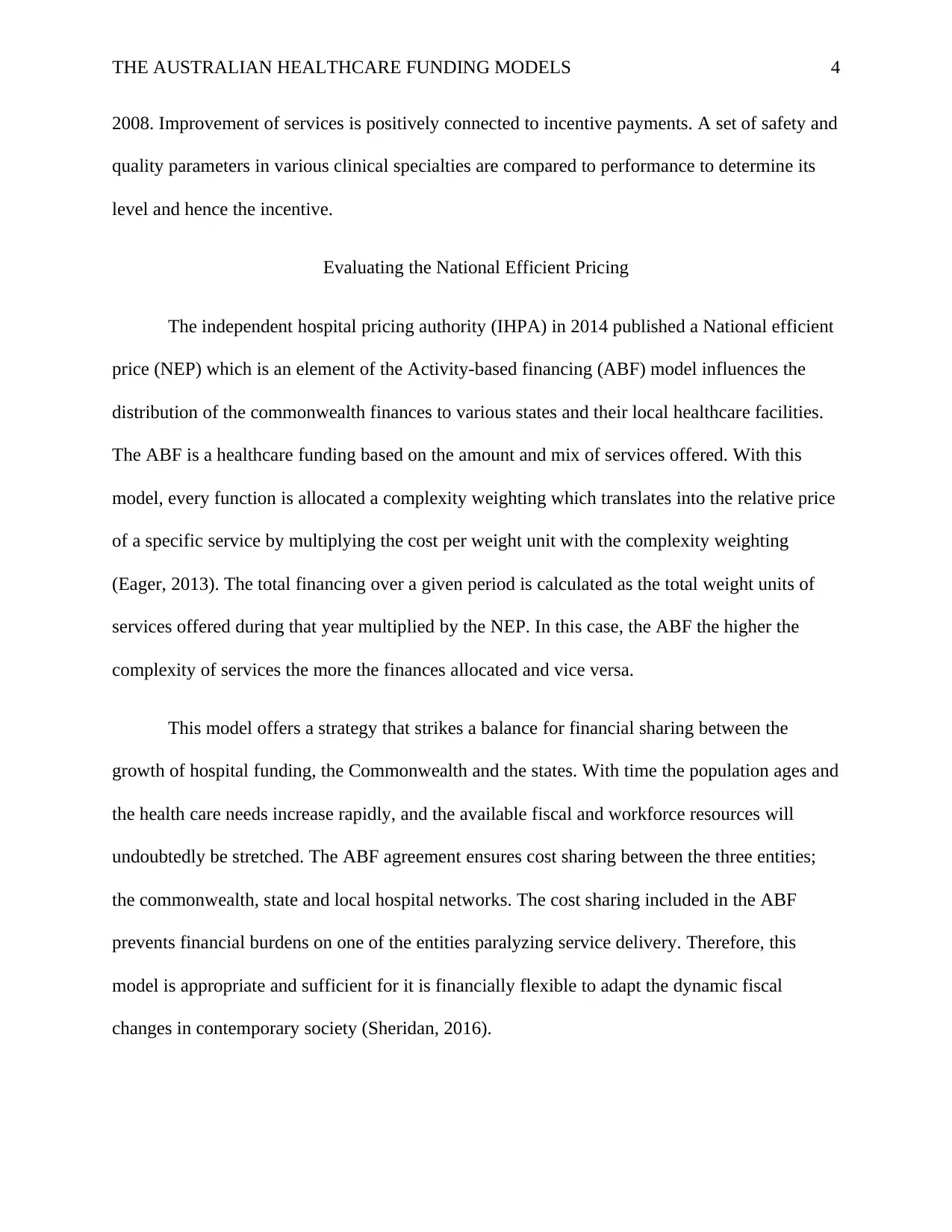
THE AUSTRALIAN HEALTHCARE FUNDING MODELS 4
2008. Improvement of services is positively connected to incentive payments. A set of safety and
quality parameters in various clinical specialties are compared to performance to determine its
level and hence the incentive.
Evaluating the National Efficient Pricing
The independent hospital pricing authority (IHPA) in 2014 published a National efficient
price (NEP) which is an element of the Activity-based financing (ABF) model influences the
distribution of the commonwealth finances to various states and their local healthcare facilities.
The ABF is a healthcare funding based on the amount and mix of services offered. With this
model, every function is allocated a complexity weighting which translates into the relative price
of a specific service by multiplying the cost per weight unit with the complexity weighting
(Eager, 2013). The total financing over a given period is calculated as the total weight units of
services offered during that year multiplied by the NEP. In this case, the ABF the higher the
complexity of services the more the finances allocated and vice versa.
This model offers a strategy that strikes a balance for financial sharing between the
growth of hospital funding, the Commonwealth and the states. With time the population ages and
the health care needs increase rapidly, and the available fiscal and workforce resources will
undoubtedly be stretched. The ABF agreement ensures cost sharing between the three entities;
the commonwealth, state and local hospital networks. The cost sharing included in the ABF
prevents financial burdens on one of the entities paralyzing service delivery. Therefore, this
model is appropriate and sufficient for it is financially flexible to adapt the dynamic fiscal
changes in contemporary society (Sheridan, 2016).
2008. Improvement of services is positively connected to incentive payments. A set of safety and
quality parameters in various clinical specialties are compared to performance to determine its
level and hence the incentive.
Evaluating the National Efficient Pricing
The independent hospital pricing authority (IHPA) in 2014 published a National efficient
price (NEP) which is an element of the Activity-based financing (ABF) model influences the
distribution of the commonwealth finances to various states and their local healthcare facilities.
The ABF is a healthcare funding based on the amount and mix of services offered. With this
model, every function is allocated a complexity weighting which translates into the relative price
of a specific service by multiplying the cost per weight unit with the complexity weighting
(Eager, 2013). The total financing over a given period is calculated as the total weight units of
services offered during that year multiplied by the NEP. In this case, the ABF the higher the
complexity of services the more the finances allocated and vice versa.
This model offers a strategy that strikes a balance for financial sharing between the
growth of hospital funding, the Commonwealth and the states. With time the population ages and
the health care needs increase rapidly, and the available fiscal and workforce resources will
undoubtedly be stretched. The ABF agreement ensures cost sharing between the three entities;
the commonwealth, state and local hospital networks. The cost sharing included in the ABF
prevents financial burdens on one of the entities paralyzing service delivery. Therefore, this
model is appropriate and sufficient for it is financially flexible to adapt the dynamic fiscal
changes in contemporary society (Sheridan, 2016).
Paraphrase This Document
Need a fresh take? Get an instant paraphrase of this document with our AI Paraphraser
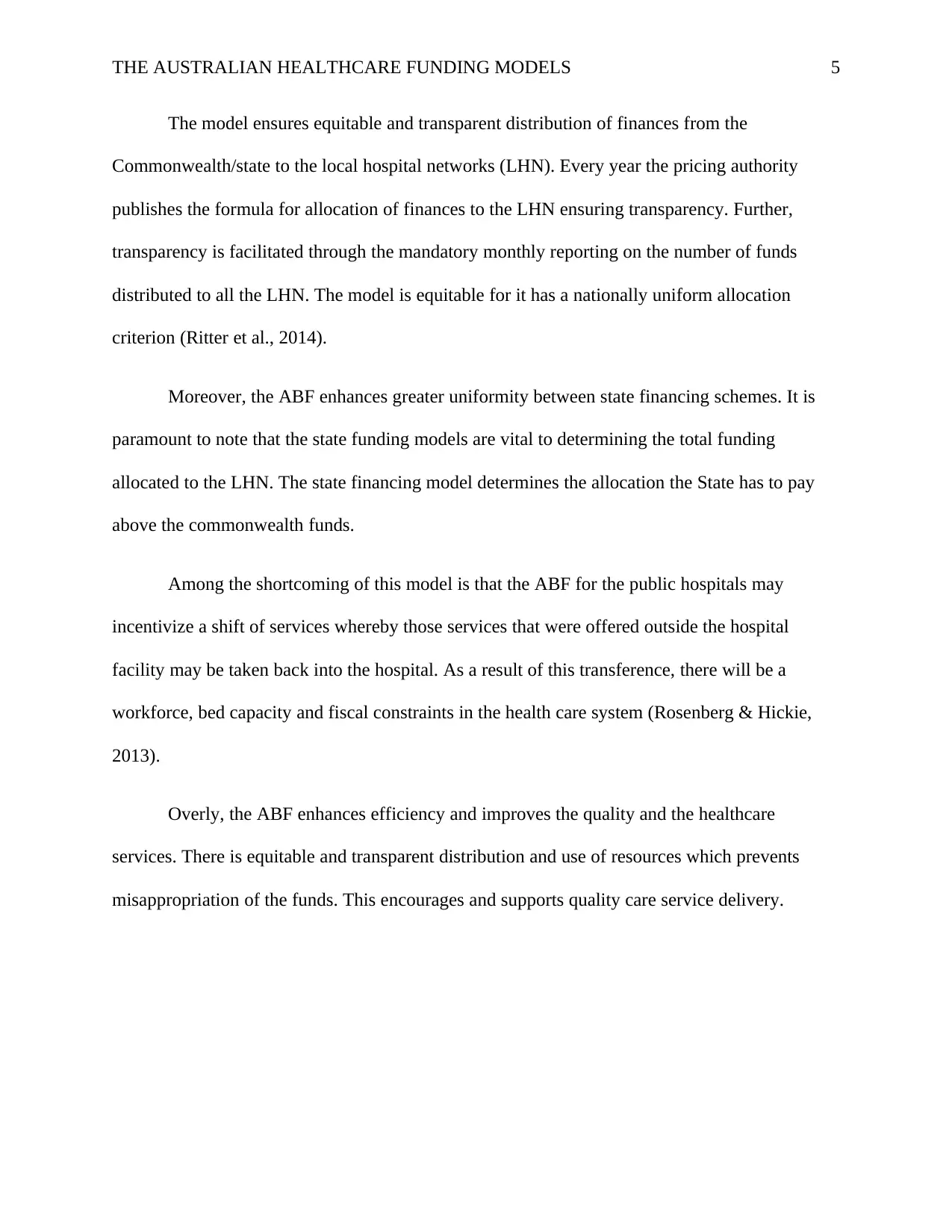
THE AUSTRALIAN HEALTHCARE FUNDING MODELS 5
The model ensures equitable and transparent distribution of finances from the
Commonwealth/state to the local hospital networks (LHN). Every year the pricing authority
publishes the formula for allocation of finances to the LHN ensuring transparency. Further,
transparency is facilitated through the mandatory monthly reporting on the number of funds
distributed to all the LHN. The model is equitable for it has a nationally uniform allocation
criterion (Ritter et al., 2014).
Moreover, the ABF enhances greater uniformity between state financing schemes. It is
paramount to note that the state funding models are vital to determining the total funding
allocated to the LHN. The state financing model determines the allocation the State has to pay
above the commonwealth funds.
Among the shortcoming of this model is that the ABF for the public hospitals may
incentivize a shift of services whereby those services that were offered outside the hospital
facility may be taken back into the hospital. As a result of this transference, there will be a
workforce, bed capacity and fiscal constraints in the health care system (Rosenberg & Hickie,
2013).
Overly, the ABF enhances efficiency and improves the quality and the healthcare
services. There is equitable and transparent distribution and use of resources which prevents
misappropriation of the funds. This encourages and supports quality care service delivery.
The model ensures equitable and transparent distribution of finances from the
Commonwealth/state to the local hospital networks (LHN). Every year the pricing authority
publishes the formula for allocation of finances to the LHN ensuring transparency. Further,
transparency is facilitated through the mandatory monthly reporting on the number of funds
distributed to all the LHN. The model is equitable for it has a nationally uniform allocation
criterion (Ritter et al., 2014).
Moreover, the ABF enhances greater uniformity between state financing schemes. It is
paramount to note that the state funding models are vital to determining the total funding
allocated to the LHN. The state financing model determines the allocation the State has to pay
above the commonwealth funds.
Among the shortcoming of this model is that the ABF for the public hospitals may
incentivize a shift of services whereby those services that were offered outside the hospital
facility may be taken back into the hospital. As a result of this transference, there will be a
workforce, bed capacity and fiscal constraints in the health care system (Rosenberg & Hickie,
2013).
Overly, the ABF enhances efficiency and improves the quality and the healthcare
services. There is equitable and transparent distribution and use of resources which prevents
misappropriation of the funds. This encourages and supports quality care service delivery.

THE AUSTRALIAN HEALTHCARE FUNDING MODELS 6
Reference
Ahmad, F. S., Metlay, J. P., Barg, F. K., Henderson, R. R., & Werner, R. M. (2013).
Identifying hospital organizational strategies to reduce readmissions. American
Journal of Medical Quality, 28(4), 278-285.
Appleby, J., Harrison, T., Hawkins, L., & Dixon, A. (2012). Payment by results. How
can payment systems help to deliver better care.
Eagar, K., Sansoni, J., Loggie, C., Elsworthy, A., McNamee, J., Cook, R., & Grootemaat,
P. (2013). A literature review on integrating quality and safety into hospital
pricing systems.
Hovenga, E. J. S., & Grain, H. (2013). Casemix systems and their applications. Health
Information Governance in a Digital Environment, 193, 316.
Ritter, A., Berends, L., Chalmers, J., Hull, P., Lancaster, K., & Gomez, M. (2014). New
Horizons: The review of alcohol and other drug treatment services in
Australia. Sydney, Drug Policy Modelling Program.
Rosenberg, S. P., & Hickie, I. B. (2013). Making activity-based funding work for mental
health. Australian Health Review, 37(3), 277-280.
Share, D. A., Campbell, D. A., Birkmeyer, N., Prager, R. L., Gurm, H. S., Moscucci,
M., ... & Birkmeyer, J. D. (2011). How a regional collaborative of hospitals and
physicians in Michigan cut costs and improved the quality of care. Health
affairs, 30(4), 636-645.
Reference
Ahmad, F. S., Metlay, J. P., Barg, F. K., Henderson, R. R., & Werner, R. M. (2013).
Identifying hospital organizational strategies to reduce readmissions. American
Journal of Medical Quality, 28(4), 278-285.
Appleby, J., Harrison, T., Hawkins, L., & Dixon, A. (2012). Payment by results. How
can payment systems help to deliver better care.
Eagar, K., Sansoni, J., Loggie, C., Elsworthy, A., McNamee, J., Cook, R., & Grootemaat,
P. (2013). A literature review on integrating quality and safety into hospital
pricing systems.
Hovenga, E. J. S., & Grain, H. (2013). Casemix systems and their applications. Health
Information Governance in a Digital Environment, 193, 316.
Ritter, A., Berends, L., Chalmers, J., Hull, P., Lancaster, K., & Gomez, M. (2014). New
Horizons: The review of alcohol and other drug treatment services in
Australia. Sydney, Drug Policy Modelling Program.
Rosenberg, S. P., & Hickie, I. B. (2013). Making activity-based funding work for mental
health. Australian Health Review, 37(3), 277-280.
Share, D. A., Campbell, D. A., Birkmeyer, N., Prager, R. L., Gurm, H. S., Moscucci,
M., ... & Birkmeyer, J. D. (2011). How a regional collaborative of hospitals and
physicians in Michigan cut costs and improved the quality of care. Health
affairs, 30(4), 636-645.
⊘ This is a preview!⊘
Do you want full access?
Subscribe today to unlock all pages.

Trusted by 1+ million students worldwide
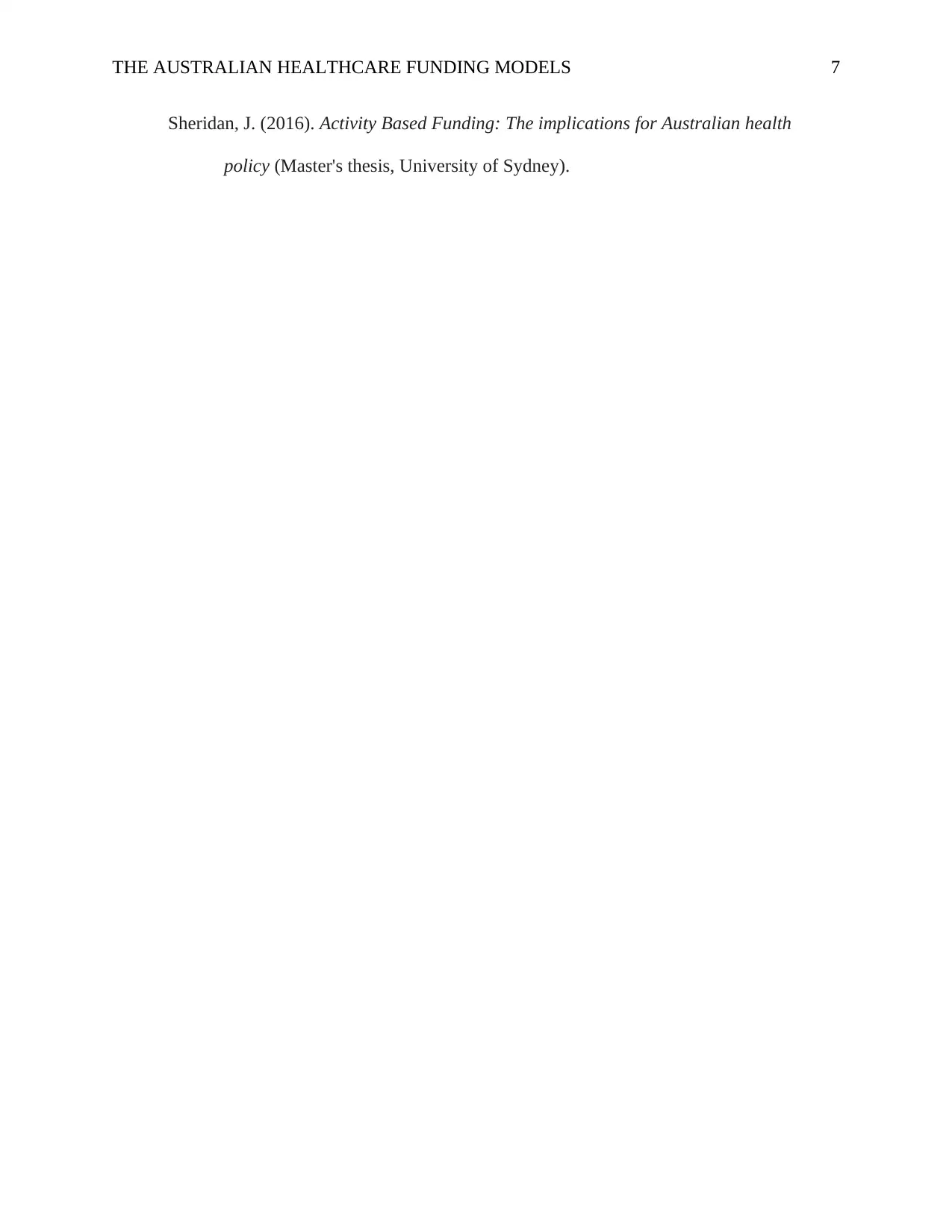
THE AUSTRALIAN HEALTHCARE FUNDING MODELS 7
Sheridan, J. (2016). Activity Based Funding: The implications for Australian health
policy (Master's thesis, University of Sydney).
Sheridan, J. (2016). Activity Based Funding: The implications for Australian health
policy (Master's thesis, University of Sydney).
1 out of 7
Related Documents
Your All-in-One AI-Powered Toolkit for Academic Success.
+13062052269
info@desklib.com
Available 24*7 on WhatsApp / Email
![[object Object]](/_next/static/media/star-bottom.7253800d.svg)
Unlock your academic potential
Copyright © 2020–2026 A2Z Services. All Rights Reserved. Developed and managed by ZUCOL.





